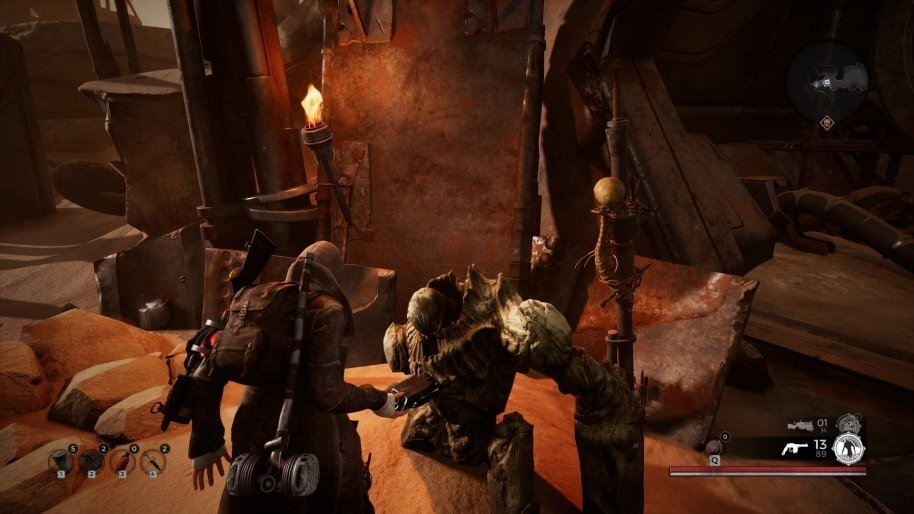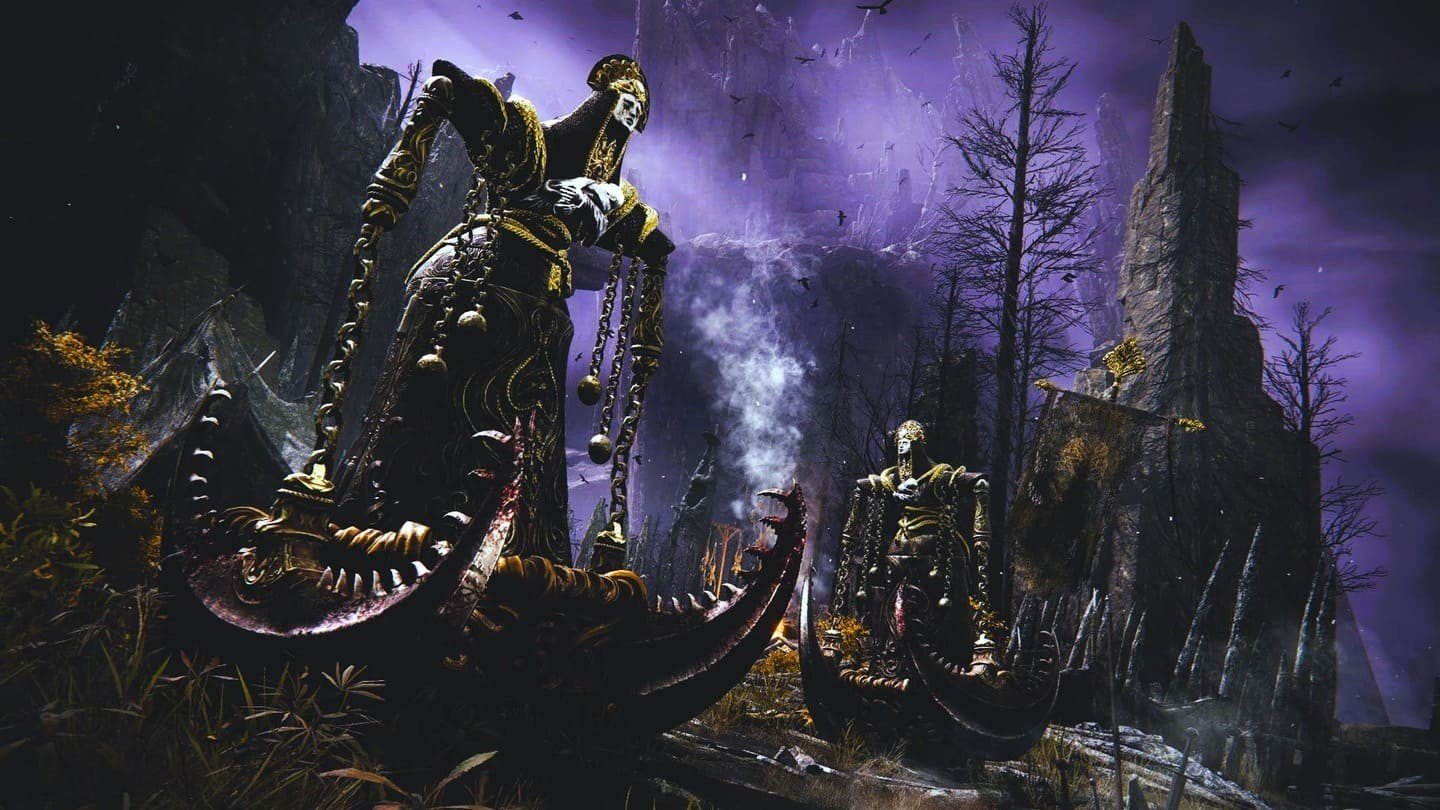In the 2010s, an interesting trend emerged: players remembered that games should not only entertain but also present a challenge. To some extent, this was addressed by increasing difficulty levels or setting various challenges for oneself (completing the game using only one weapon, completing without rewinding time, etc.). However, more often than not, this didn’t lead to a qualitative increase in gameplay difficulty, but simply altered the numbers for incoming/outgoing damage.
 Image: reddit.com
Image: reddit.com
This moment was triumphant for the Japanese studio FromSoftware and lead game designer Hidetaka Miyazaki. They managed to offer users what they needed in the Dark Souls series and other creations, namely:
☠️ Heighten the emotions of caution and fear when entering each new location;
☠️ Deliver unforgettable joy from even the smallest progress (a new save point, a new character level).
 Image: en.as.com
Image: en.as.com
This combination of elements became the recipe for the popularity of projects that were later even united under a common genre name, "souls-like". In this material, we will talk about the 20 best games in this genre.
From Software proudly presents
Dark Souls
 Image: zombie.co.uk
Image: zombie.co.uk
- Release date: September 22, 2011 (Vanilla), May 24, 2018 (Remastered)
- Developers: FromSoftware, QLQC (Remastered)
- Download: Steam
We should start the list with the progenitor of the franchise — Dark Souls. The plot revolves around the rebirth of worlds (as does the rest of the DS trilogy). The main character, Hollow, is a cursed undead who hasn’t yet lost his mind and initially tries to survive, but gradually takes the fate of the kingdom of Lordran into his own hands.
It’s great if you understand this on your first playthrough because the narrative design, where most of the game’s information isn’t directly given to the player but is hidden in item descriptions and NPC hints, is a hallmark of the franchise.
From a genre perspective, Dark Souls is an Action game with RPG elements. Leveling up, different weapons, and armor are indeed present. But here’s some wise advice — do not play Dark Souls like a classic RPG where attack and defense stats are everything. In this game, even a mob from the starting area can kill your character in, say, 3 hits instead of 6, and in some cases, one hit could be fatal. So, you won’t feel invincible.
What you will definitely experience is the deep narrative, the stunning level design (shortcuts in this title are an art form), and the regular feeling of dread as you approach the white fog that precedes boss arenas. And, of course, you will become immersed in the despair of a dying world, where the choice remains with you: to end the cycle of rebirths or give this world one more chance.
Dark Souls II
 Image: theguardian.com
Image: theguardian.com
A few years after the success of the first project, the sequel was released. The plot is connected to its predecessor only by the overarching concept of the world’s cycle of rebirth and the curse of losing humanity, turning those around you into hostile hollow undead. Here, the player dives into the story of the kingdom of Drangleic (with the help of a cat who regularly explains the less obvious details of the game’s lore), collects 4 Great Souls, and embarks on a journey into the past to prevent darkness from consuming the world.
Compared to its predecessor, Dark Souls II offers a wider variety of biomes and locations, many of which are majestic castles, an increase in weapons, and a larger number of bosses (focused more on humans and humanoid creatures).
However, players note that the game’s relative ease and its generosity with experience points allow players to become overpowered by the middle of the main quest (and yes, even the infamous adaptivity stat doesn’t save you from an abundance of experience). Moreover, the game became more linear, and the connection between some locations raises questions about the level design.
Nevertheless, Dark Souls II was a solid continuation of the genre and a platform for further improvement. While it may not be the best starting point for diving into the souls-like genre (the first game in the franchise is more fitting for that), fans of the series will certainly find several dozen hours of intense emotions and experiences.
Dark Souls III
 Image: amazon.co.uk
Image: amazon.co.uk
- Release date: April 12, 2016
- Developers: FromSoftware
- Download: Steam
A few years later, and after the release of Bloodborne on PS4 (to the disappointment of many users, a PC re-release never happened, becoming a meme within the souls-like community), the third and likely final part of the franchise was released.
The plot intersects significantly with the first part of the trilogy: the player once again deals with the world’s cycle of rebirth in Lothric, there are swamp locations (though inconvenient swamps are one of the series' trademarks), and the overall goal remains the same — to reach the Kiln of the First Flame to confront yet another Lord of Fire in this world.
The combat system has made noticeable progress. While the first two games in the franchise encouraged the use of heavy armor, shields, and two-handed weapons, capable of defeating bosses in a few hits with proper leveling, the third project is more dynamic, urging players to shift from the "turtle" playstyle (for which many bosses now punish) to dodging and parrying. Additionally, the title finally introduced a mana bar, making mage playthroughs more viable.
Dark Souls III is rightfully considered by genre fans as one of its exemplary titles. It is harder than both the first and second parts, but it offers a faster and more dynamic gameplay experience, which has been adopted by many other souls-like titles. I recommend starting your introduction to this game genre either with DS or DS III.
Sekiro: Shadows Die Twice
 Image: playstation.com
Image: playstation.com
- Release date: March 22, 2019 (Game of the Year Edition)
- Developers: FromSoftware
- Download: Steam
Let’s take a brief detour from the dark souls and look at other projects by Hidetaka Miyazaki. Sekiro is a more intimate story (especially compared to the epic scales of previous projects) about a bodyguard set in medieval Japan. Fans of Eastern traditions and mythology will surely appreciate this title, as many enemies, bosses, and project details are direct references to the myths of the Land of the Rising Sun (such as the three monkeys or Eastern dragons).
However, Sekiro is vastly different from the Dark Souls franchise, as it is more of a rhythm game. For successful progression, the player must focus not on dodging enemy attacks but on timely blocking them and, after depleting the opponent’s stamina bar, delivering a fatal blow. For bosses, this operation must be performed three, sometimes even four times.
All of this turns Sekiro into an engaging blade dance (as there is no other weapon in the game), where every move must be executed with millisecond precision, and missing a beat results in death.
As mentioned, there is no weapon variety or leveling. Some gameplay diversity is achieved through other technological solutions built into the protagonist’s prosthetic arm (such as fireworks, an umbrella shield to block projectiles, etc.). However, this does not make the gameplay feel lacking: in fact, the katana fits this world and setting far better than a hammer or halberd.
Elden Ring
 Image: reddit.com
Image: reddit.com
- Release date: February 25, 2022
- Developers: FromSoftware
- Download: Steam
The latest project in the souls-like theme from FromSoftware is Elden Ring. While it inherits much of the fast combat mechanics from Dark Souls III (to the point of borrowing certain attacks and movements), this new entry impresses with its variety of weapons, side mechanics (such as spirit summoning, elixirs), and classes (yes, this title finally made a playable version of clerics, a longstanding meme in the souls community).
However, the main difference in this part is the open world. Strangely enough, this decision is considered highly controversial by many fans of the series. Earlier FromSoftware projects were linear games where progression was often blocked by a difficult boss or area that could not be bypassed without using bugs.
In Elden Ring, however, some biomes can be "skipped", allowing players to enter new areas with very low levels and poor equipment (although hardcore fans still manage to beat the game "Fred Flintstone style"), or on the contrary, over-level and breeze through story locations. The same ambiguity applies to quests — in other studio projects, certain quests could not be bypassed, while in an open world, it’s much easier to miss a crucial cave or NPC’s building.
Otherwise, the title truly delights with its variety of biomes, colorful swamps (of course), intricate architecture, and many unique gameplay situations. Despite the open world being added to appeal to new fans, I wouldn’t recommend starting with this title if you're new to the souls series. But for genre lovers, it's definitely a must-have!
Souls Wannabes
The sudden success of Hidetaka Miyazaki couldn't go unnoticed, and several renowned and lesser-known game studios attempted to create their own Souls masterpiece. In this section, I’ll talk about the most "notable" imitators of the original titles.
Lords of the Fallen
 Image: lordsofthefallen.fandom.com
Image: lordsofthefallen.fandom.com
- Release date: October 28, 2014
- Developers: Deck13 Interactive, City Interactive
- Download: Steam
The first of the Dark Souls clones appeared even before the release of the third part of the franchise. Lords of the Fallen transports players to a setting based on Nordic legends, where the hero must confront the supreme deity of the world, Adyr, as well as other mythical creatures. One of its strengths is the wide arsenal of weapons, with a particular focus on hammers (how could they not be in Scandinavian legends?).
Otherwise, it’s almost a copy of Dark Souls: tough mobs, tough bosses, minimal room for error. Sometimes, there’s questionable hit detection and choppy animations, which make an already difficult playthrough even harder. The project is characterized by a grim setting, and as a result, the variety of locations is quite limited.
Additionally, the influence of earlier FromSoftware games is felt, with a slower combat system, making it suitable only for hardcore souls-like fans who are interested in seeing the first attempt to make "their own Dark Souls with blackjack".
Lords of the Fallen (Remake)
 Image: ftw.usatoday.com/
Image: ftw.usatoday.com/
- Release date: October 13, 2023
- Developers: CiGames
- Download: Lordsofthefallen
The sequel to the game above didn’t work out, so 10 years later, a remake of the project was released under the same name. However, calling it a remake is difficult, as only the core plot remains. The locations, combat, and many enemies were reimagined and reworked, improving the title significantly.
One of the highlights is the time-travel mechanic, which wasn’t in the original. Sometimes it plays a gameplay role (necessary for progressing through locations), and other times it can be activated by the player simply for fun.
The overall setting remains dark, with most of the project taking place in catacombs and caves, so fans of vibrant and colorful design might find the project dull.
The combat system is faster than in the 2013 title, but it still hasn’t achieved proper balance and failed to fix some of the hit detection issues of its predecessor. It’s certainly more worthy of attention than its 10-year-old counterpart, but it still falls short of Dark Souls III.
Lies of P
 Image: playsense.nl/
Image: playsense.nl/
- Release date: September 19, 2023
- Developers: NEOWIZ
- Download: Steam
What if we turned children’s fairy tales into dark fantasy and added souls-like mechanics? That’s what we get in Lies of P, where children's toys, soldiers, dolls, robots, and even Brother Rabbit all have one goal — to kill us. The action takes place in the fictional city of Krat. Unlike the previous two titles, the setting involves battles in houses, buildings, and the streets of the city, making it closer to Bloodborne in this respect and in its combat system (which even includes firearms).
There is also an attempt to introduce elements from Sekiro: in some battles with bosses and strong opponents, the player must knock them off balance with attacks to land a powerful hit. However, while in Sekiro such a hit is fatal, here it merely allows you to deal significant damage, though the risk of rushing and receiving a counterattack is often too high to build your strategy around this approach.
Overall, thanks to its interesting setting, story, and fairly dynamic combat, Lies of P certainly deserves attention.
Mortal Shell
 Image: windowscentral.com
Image: windowscentral.com
- Release date: August 19, 2021
- Developers: Cold Symmetry
- Download: Steam
This spiritual successor to the Dark Souls series is considered something of an indie title in the souls-like universe. And for good reason — the game was developed by only four people! Otherwise, we get the same classic souls-like formula: dark design, an atmosphere of despair, well-designed enemies and bosses, high difficulty, and an unforgiving combat system.
One of the most interesting mechanics is the "shell" system — the souls of fallen warriors, each granting specific skills and requiring a particular playstyle.
On the downside, the game is relatively short (10-15 hours to complete) and clearly doesn’t aim for AAA status — some locations feel empty, and there are occasional rough transitions in character and enemy animations. Still, the title doesn’t aim for anything more, and for its price, it offers an intriguing story and gameplay.
Two Dimensions are Enough for Souls-like
The success of Dark Souls in three dimensions inevitably inspired developers of two-dimensional games to try to replicate its success in the "flat world". Of course, one could argue that Ghosts'n'Goblins and Battletoads already exist, and the concept of unforgivingly difficult projects was well established on the NES. Nonetheless, interesting projects emerged here with the same notes of decadence and tension that are characteristic of the Souls series.
Hollow Knight
 Image: microless.com
Image: microless.com
- Release date: February 25, 2017
- Developers: Team Cherry
- Download: Steam
When talking about atmospheric titles, Hollow Knight certainly belongs among them. The design, soundtrack, plot, and visual storytelling all combine to create a synergy that makes you want to return to Hallownest again and again. And this is despite the classic difficulty of Souls games, multiplied by the hardcore platforming elements of the project.
In general, Hollow Knight is a Souls-like + Metroidvania, where the main character (a cute little bug) must regularly return to previously explored locations and battle other insects infected by the Plague. The story may not seem overly complex, but the way it’s conveyed through signs, notes, dialogues, and characters' thoughts, combined with its level of detail, makes you forget that you’re playing a two-dimensional game and genuinely sympathize with the protagonist on his journey deeper and deeper underground.
Read also
Blasphemous
 Image: powerups.es
Image: powerups.es
- Release date: September 10, 2019
- Developers: The Game Kitchen
- Download: Steam
Players who experienced the NES, SNES, and Sega Genesis era will remember the two-dimensional Castlevania games before they became full-fledged RPGs. In this sense, Blasphemous is their spiritual successor, both in terms of difficulty and atmosphere.
The main character is the Penitent One, a silent knight who must make a pilgrimage through the lands of Cvstodia, where the presence of The Miracle has altered the world with its blessings and curses. The project is filled with references to medieval Spanish Catholicism and is fascinating both visually and culturally.
The gameplay has an interesting mechanic: each death adds a Guilt fragment, which reduces the amount of in-game currency earned. To regain the previous amount, you must reach the place of your death and destroy it or seek forgiveness from special NPCs. This feature forces players to weigh the risks of venturing too far from save altars with low health.
Death's Gambit
 Image: gamemaker.io
Image: gamemaker.io
- Release date: August 14, 2018
- Developers: White Rabbit
- Download: Steam
Another title visually resembling Castlevania but mechanically similar to Dark Souls. In this project, you control a fallen warrior who has made a pact with Death, allowing the character to return to the world of the living. The game features leveling, classes, and the ability to choose various perks, creating a semblance of build variety.
Death's Gambit also inherits the control system and responsiveness from Castlevania (especially from the very first part). While this was accepted as standard in the 80s-90s, today's players may find the unresponsive controls off-putting, especially in the platforming segments. However, enemy and boss timing is understandable and can be learned, making the control issues less critical, especially for fans of Souls-like projects.
Salt and Sanctuary
 Image: 3rd-strike.com
Image: 3rd-strike.com
- Release date: May 18, 2016
- Developers: Ska Studios
- Download: Steam
Another example of a Souls-metroidvania set in a two-dimensional world. You play as a shipwreck survivor exploring a mysterious island filled with mystical creatures and monsters. As you progress, you’ll find new equipment that will significantly alter your stats (for example, heavy armor slows down your character, which is rare for two-dimensional titles).
Additionally, familiar to Dark Souls fans, stamina management is present – you won’t be able to continuously attack or dodge, and every action will need to be carefully considered. Salt and Sanctuary will undoubtedly appeal to fans of three-dimensional Souls-likes who are looking to diversify their experience with two-dimensional adventures.
Souls-like, but Unique!
This section is dedicated to games that offer players something unique compared to the original FromSoftware franchises. Of course, this perspective is quite subjective, and you may want to add other titles to our selection. Those wishing to share other hidden gems are invited to the comments!
Remnant: From the Ashes
 Image: 3djuegos.com
Image: 3djuegos.com
- Release date: August 20, 2019
- Developers: Gunfire Games
- Download: Steam
The entire Souls series is an Action RPG where ranged weapons have either appeared as bows or as a parrying tool (as in Bloodborne), but they have never served as the foundation for a standalone build. The developers of Remnant attempted to transfer souls-like mechanics into a third-person shooter. And it must be said, they succeeded!
Earth has experienced an apocalypse, and you are one of the survivors trying to stop the advance of an unknown entity called "The Root", which turns humans and animals into dendromorphic mutants. You eliminate them and the bosses with a vast arsenal of firearms — shotguns, sniper rifles, revolvers, etc.
Additionally, the character can insert talismans into their weapons, temporarily increasing damage or providing healing, which charges through killing enemies, offering significant gameplay variety.
Unfortunately, the story suffers from a disjointed pace and can be unclear at times, but this doesn’t prevent players from enjoying a well-designed combat system that turns each fight into a thrilling gun duel. Cooperative PvE mode adds even more fun.
Remnant II
 Image: versusmedia.mx
Image: versusmedia.mx
- Release date: July 26, 2023
- Developers: Gunfire Games
- Download: Steam
Sequels rarely surpass the quality of the originals, especially if they come from the same generation (this is true for both films and games). Remnant II is a pleasant exception to this rule. Essentially, the project took all the successful mechanics and ideas from the original and improved them.
The second part introduced three full-fledged classes with different abilities and expanded the arsenal of weapons (though not quite on the scale of Borderlands, but still very diverse). Now, the game can even be played with melee weapons (which was harder in the first game, where close combat was more of a backup option than a primary playstyle). The procedural level generation from Remnant: From the Ashes was refined, making the world more coherent and rich in content.
Nioh
 Image: guiltybit.com
Image: guiltybit.com
- Release date: November 7, 2017
- Developers: Team Ninja
- Download: Steam
Of course, FromSoftware wasn’t the only Japanese studio developing souls-like games. Team Ninja also had their moment in the spotlight when they released the historical-fantasy title Nioh, which tells the story of William Adams, a traveler and real historical figure, as he battles bandits, mystical creatures, and demons in medieval Japan (though historical accuracy is not guaranteed).
The game’s unique feature is the ability to use and combine combat stances (high, medium, and low), which affect attack speed and damage. Players must also manage their stamina bar — running out leaves the protagonist defenseless. While the game didn’t achieve the success of the original Dark Souls, fans of Japanese culture and dynamic combat will certainly enjoy it.
Nioh 2
 Image: 3djuegos.com
Image: 3djuegos.com
- Release date: February 5, 2021
- Developers: Team Ninja
- Download: Steam
The second part of the franchise is quite different from the first. The protagonist is now a young samurai who discovers his spirit power, known as Youkai, and must battle similar spirits, demons, and hostile ronin. The character customization has become more detailed, allowing for a wider variety of playstyles.
The combat system is more dynamic, with the ability to dual-wield weapons, as well as Youkai special abilities. The graphics have also seen an upgrade, making battles look much more colorful. Players also say that the second part is somewhat easier than the original, making it more accessible to casual gamers. For some, this might be their first souls-like experience.
Code Vein
 Image: areajugones.sport.es
Image: areajugones.sport.es
- Release date: September 5, 2019
- Developers: Bandai Namco Studios
- Download: Steam
Continuing the theme of Japanese souls-like projects, I present Code Vein. The vibrant anime style mixed with the harsh reality of overcoming a hostile game world is a potent combination! The plot unfolds in a post-apocalyptic future where Revenants — humans who need to consume blood to avoid going berserk and turning into Lost — reside.
In search of mysterious "relics", the player will explore the ruins and catacombs of the future, fighting Lost and the monsters they’ve spawned. The core of the combat is quick attacks and dodges, making battles in Code Vein dynamic in the best AMV traditions. Despite being a souls-like, the game isn’t as punishing, making it challenging but not impossible even on the first playthrough. As a result, the title may be a good first step into the souls-like genre for anime fans.
Star Wars Jedi: Fallen Order
 Image: ea.com
Image: ea.com
- Release date: November 15, 2019
- Developers: Respawn Entertainment
- Download: EA
Another addition to the "casual" (if that term even applies here) souls-likes is a game from the Star Wars universe. You control a Jedi Padawan, Cal Kestis, hunted by the Galactic Empire, as he embarks on a difficult quest to reunite the Jedi Order.
The gameplay can be compared to Sekiro: the player has a lightsaber, which they use to parry and block enemy attacks, while others can only be dodged.
The progression system is relatively simple, but this doesn’t detract from the dynamic gameplay. Additionally, the title places a heavy emphasis on platforming — the player will regularly solve spatial puzzles and make precision jumps. Add to this a solid and comprehensible story, and you’ve got a recipe for a popular "casual souls-like".
The Surge
 Image: tecnogaming.com
Image: tecnogaming.com
- Release date: May 16, 2017
- Developers: Deck13
- Download: Steam
We end our selection with a souls-like in a futuristic setting. The story revolves around the massive CREO factory, where a catastrophe has turned the workers into monsters. The player must navigate through this industrial hell to stop the disaster and uncover the truth.
One of the game’s unique features is the constant change of weapons and armor, obtained by defeating enemies. This forces the player to engage in combat with tougher mobs to acquire better gear, making progression easier. This project is sure to captivate fans of science fiction and those who enjoy robot-themed post-apocalyptic settings.
We’ve covered 20 of the best souls-likes, all of which are worth playing, whether you’re a genre fan or a newcomer. Each of these projects will provide a sense of challenge and the satisfaction of overcoming it when you finally defeat another powerful boss. Thank you for reading, and feel free to share in the comments which game from this genre you think is the best and why.
Main image: wallpaperbat.com




















0 comments